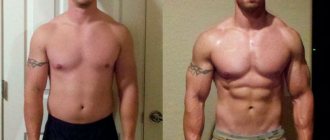The presence of a large layer of fatty tissue, sometimes mistaken for a “broad bone,” causes severe discomfort to a person who is trying to lose weight or gain muscle. In appearance, the physique is strong, developing in width, and belongs to the endomorphic type. The owner of such a constitution faces several problems - it is difficult to lose weight, and when building muscle mass, the muscle definition is not visible. It is important to understand the features of this structure in order to choose the right nutrition and training plan.
Main features of the endomorph type
The endomorph has a large build with short limbs relative to its body. The volume of the abdomen prevails over the chest. In the endomorphic type, in comparison with other somatotypes, adipose tissue and the size of internal organs predominate in the body, muscle tissue is poorly developed. The tendency to be overweight and obese is associated with the increased function of corticosteroids and glucocorticoids, which increase the synthesis of lipids, cholesterol, and contribute to increased blood sugar. Also, the type is faced with fluid retention in the body due to the hyperfunction of mineralcorticoids that retain salt, and this, in turn, helps to increase vascular tone, due to which the type is prone to hypertension.
Examples of menus for endomorph athletes[edit | edit code]
Nutrition pyramid
Sample menu for endomorph athletes (prone to overweight) weighing approximately 80 kg:
- 1 p.p. - dense: 5-6 egg whites, whole grain bread, fruit juice, or green or herbal tea.
- 2 p.p. - light: low-fat cottage cheese or cheese, 1-2 apples.
- 3 p.p. - dense: vegetable salad, beef, poultry or fish.
- 4 p.p. (0.5-1 hour before training) - light: protein drink, maybe 1-2 apples.
- 5 p.p. (10-30 minutes after training) - light: protein drink.
- 6 p.p. (1.5-2 hours after training) - dense: vegetable salad, fish or poultry, rice.
- 7 p.p. (30-40 minutes before bedtime) - light: cottage cheese, kefir or protein drink.
These two diets contain approximately: calories from 3000 to 4000, protein from 300 to 350 g, carbohydrates from 250 to 450 g, fats from 30 to 60 g (the range depends on the size of your portions).
On training days, increase the proportion of carbohydrates and fats in your diet to provide the body with additional energy, and on rest days, increase protein for muscle growth. Note to endomorphs. For those who are prone to obesity, we can recommend the following type of diet, which is popular among professionals: carbohydrates and proteins are consumed separately. A bodybuilder eats approximately 2/3 of his daily carbohydrate intake before noon. Protein intake occurs for the rest of the day. Moreover, at first there are few proteins, and then their amount increases from one meal to another (in the afternoon the bodybuilder eats at least 3-4 more times). This nutritional method has an amazing effect: muscle mass grows, and at the same time excess fat disappears relatively quickly.
Endomorph nutrition
Rule #1
It is necessary to minimize fat intake. This does not mean their complete exclusion, although the physique is inclined to store them. It is important to consume only unsaturated fatty acids, for example, unrefined olive oil, flaxseed oil, sesame oil and the like. You should limit yourself to taking 1 tbsp. l. oils in the morning. The body will have time to expend these calories during the day, especially since this will help remove free fats. Fats in the diet should contain no more than 10% of total calories.
Rule #2
Eliminate consumption of simple carbohydrates. The blood of an endomorph already has a high glucose content; frequent consumption of sugar over time can reduce glucose tolerance and insulin production, and this will trigger the development of diabetes. Refusal of fast carbohydrates will help, firstly, to maintain health, and secondly, to avoid fat accumulation and even reduce the existing subcutaneous layer. This will also avoid excess visceral fat on the internal organs.
Rule #3
Complex carbohydrates should be as long-digesting as possible. A long absorption process occurs due to the high content of solid dietary fiber (fiber), for example, brown rice, buckwheat, oatmeal, green vegetables. Cereals and grains should be consumed in the first half of the day. This is important because their intake at a late time threatens to convert excess energy into fats. The carbohydrate content in an endomorph's diet should be 30% of the total calorie content.
Rule #4
Protein takes up the majority of the total calorie intake. About 60% of calories should be consumed from protein foods, such as meat, fish, eggs, dairy products. Proteins cannot be absorbed in the body in the form of subcutaneous fat and do not cause insulin spikes. They are necessary for building new cells, including muscle tissue.
Endomorph[edit | edit code]
Endomorph. The Best Men's Workout Program for Muscle Growth
Three body types are depicted: ectomorph, mesomorph and
endomorph.
Body Types
Endomorph nutrition - recommendations and tips
Endomorph
- a type of human physique or constitution, identified by the American psychologist Sheldon, along with mesomorph and ectomorph.
A pure endomorph is characterized by spherical shapes, as much as possible for humans. Such a person typically has a round head, a large belly, a broad chest and torso, short stature, with a lot of fat on the shoulders and hips, but thin wrists and ankles. This body constitution is largely accompanied by excess fat deposition; this can be avoided by properly designed training for an endomorph and nutrition.
A positive quality of this body type is its large, wide bone structure. Gaining muscle mass is quite easy, but getting rid of excess fat becomes extremely difficult. In many cases, endomorphs gain excess weight exactly where they don’t need it - on the chest, waist and buttocks.
When an endomorph begins to engage in bodybuilding or other strength sports, he begins to gain body weight quite quickly. However, often all achievements remain hidden under a layer of fat. The body of an endomorph can be as hard as a rock, but few manage to achieve good relief and muscle definition. Most often, this requires the use of sports nutrition for relief and a special diet.
Sports nutrition for endomorphs
Sports supplements, like food, should help build muscle or burn fat, but in no case contribute to the accumulation of fatty tissue. Therefore, gainers, complex proteins, bars and creatine are prohibited Pre-workout complexes containing creatine are also excluded due to the accumulation of excess fluid in the muscles.
What supplements do endomorphs need?
- To reduce adipose tissue, and this is an advantage for obtaining a high-quality form, fat burners can be used, which will reduce appetite and help obtain additional energy. Safer dietary supplements contain caffeine, yohimbine, and green tea. However, all alkaloids increase blood pressure, so hypertensive patients should avoid such supplements .
- L-carnitine is a vitamin-like substance that, when taken additionally from sports nutrition supplements, promotes the transport of fatty acids into the mitochondria, increasing energy in the muscles where it is most needed. L-carnitine acts as a light energy booster and also promotes speedy recovery. An important condition is that the supplement be encapsulated or in a dry pure form without carbohydrates and other impurities.
- Full-cycle amino acids, BCAA and whey protein isolate - the most fat-free and lactose-free type of powder - are suitable directly for feeding the muscles themselves, as a meal replacement.
Advantages of somatotype
Endomorph - who is it really in sports? As a rule, these are powerlifters with huge waists and impressive strength indicators. In general, endomorphs have a number of advantages over other body types. Some features of the self-type, when used correctly, are especially relevant for maintaining a figure for women.
- Ability to maintain shape. A slow metabolism is not only a curse, but also an advantage. After all, it is thanks to it that catabolism can be significantly slowed down and a favorable anabolic background can be created.
- Less energy consumption. To get started, endomorphs only need a small impulse. Their performance increases even after light loads.
- Less financial expenses. Endomorphs are like Japanese cars - they consume a minimum of fuel and drive very far. They do not require an extreme calorie content of 5-6 thousand kilocalories. It is enough to add 100 kcal to the regular menu to start metabolism.
- The ability to easily tolerate any diet without further slowing down your metabolism. Since the body is already optimized for hunger, it will easily begin to burn fat reserves even on the most extreme diets. Further slowing down of metabolism is simply impossible, due to its speed on the verge of a basal minimum.
- Reserve for accelerating metabolic processes. If it is necessary to dry out or lose most of the weight, ecto- and meso- may have problems. Endomorphs will never have them. After all, they have overclocking potential. Endomorphs accelerate their metabolism up to 5 times, which leads to almost complete elimination of excess fat.
- Huge reserves of cholesterol. This allows you to synthesize more testosterone. Have you noticed that bearded people are generally plumper? They also use excess hormones for training. More testosterone - more muscles - more strength!
© rudall30 — depositphotos.com
Workouts for the endomorph
In order for the appearance of an endomorph to approach an aesthetic athletic physique, it is necessary to get rid of adipose tissue, depending on its thickness, and then work on muscle volume, if necessary. Strength training should be combined with cardio. For example, 3 strength and 1 cardio workouts per week.
Complex for a week
Day 1
Superset 3-4 x 14-16.
- Squats.
- Farmer's walk with barbell.
Superset 3-4 x 14-16.
- Pull of the upper block behind the head.
- Pull the block in front of you with a wide grip.
Superset 3-4 x 14-16.
- Horizontal block row for the rear deltoids.
- Abduction of arms in the simulator.
Press. Superset 3-4x20-30.
- Raising the body on a Roman chair.
- Leg raises on parallel bars.
Day 2
Superset 3-4 x 14-16.
- Romanian cravings.
- Leg bending.
Superset 3-4 x 14-16.
- Seated dumbbell press.
- Front swings.
Superset 3-4 x 14-16.
- Curls with a barbell on a Scott bench.
- Lifting dumbbells with a hammer grip.
Press: repeat 1 day.
Day 3
Superset 3-4 x 14-16.
- Leg press.
- Seated leg extension.
Superset 3-4 x 14-16.
- Bench press.
- Dumbbell raises at an angle of 45, 30, 45 degrees.
Superset 3-4 x 14-16.
- Extension of arms from the upper block.
- Dumbbell extension from behind the head.
Press: repeat 1 day.
Day 4
Cardio training – 60 minutes.
Body Flaws
Endomorphs, as well as other types, have their disadvantages, which for most become a stumbling block when achieving serious results in sports.
- Predominance of fat layer. Yes, yes... No matter how much we talk about the fact that a slow metabolism is an advantage, most people do not know how to use it. Therefore, most endomorphs suffer from excess weight.
- Long recovery between workouts. A slow metabolism slows down recovery processes between workouts. As a rule, this means that you cannot train more than 3 times a week, at least without the use of additional stimulation from the hormonal system through the use of AAS.
- The presence of increased load on the heart muscle. Excess weight and a large cholesterol depot are problems for most endomorphs. The heart works at elevated frequencies all the time, sometimes on the verge of fat burning. Therefore, endomorphs often suffer from heart pain. It is very easy for them to get a “sports heart”, so endomorphs should approach cardio exercises with extreme caution and constantly monitor their pulse.
Important: despite the external characteristics and descriptions of all three human somatypes, you need to understand that in nature there are no pure endomorphs, mesomorphs, or ectomorphs. This is unprofitable from an evolutionary point of view. It is quite possible that you have key characteristics from each somatotype, mistakenly classifying yourself as one of them. But the main mistake is that most overweight people blame their somatotype for everything, which is fundamentally wrong. Most often, obesity is a consequence of disrupted eating plans and an unhealthy lifestyle, and not at all the result of a tendency to gain weight.
Typical characteristics of the somatotype
Before defining an endomorph, you need to pay attention to how such a somatotype, unprepared for sporting achievements, appeared. The physique of an endomorph, like a mesomorph and an ectomorph, is the result of long-term evolution.
Almost all modern endomorphs are, to one degree or another, descendants of people from the northern lands. In the north, people led a predominantly nomadic lifestyle, and their main food was fish or herbivores. As a result, meals were unstable and infrequent. To adapt to constant hunger, the body gradually slowed down its metabolism and brought optimization processes to a new level. Therefore, to saturate, an endomorph needs significantly less energy than any other type. Endomorphs age more slowly and are rather sedentary in their lifestyle.
| Characteristic | Meaning | Explanation |
| Weight gain rate | High | Basal metabolism in endomorphs is aimed at extreme slowdown. As a result, they store any excess calories in energy carriers, namely in fat depots. This can be easily corrected after several years of exercise, when a person develops a large glycogen depot into which the main reserves of excess calories are redistributed. |
| Net weight gain rate | Low | Endomorphs are the only species in pure manifestation that is not tuned to increased physical activity. Their main task is a powerful heart that is capable of pumping blood for a long time. All known endomorphs are good marathon runners, since their body is able to use fat reserves instead of glycogen. |
| Wrist thickness | Thin | The absence of constant physical activity forms the optimal muscle/bone thickness ratio for the body. Since this is the most optimized human somatotype, his bones, as the main consumers of calcium, are reduced. |
| Metabolic rate | Very slow | Endomorphs are most adapted to long-term survival in conditions of famine. Because of this, their initial metabolic rate is significantly lower than that of other somatotypes. |
| How often do you feel hungry? | Rarely | The reason is the same - slow metabolism. |
| Ratio of weight gain to calories consumed | High | Basal metabolism in endomorphs is aimed at extreme slowdown. As a result, they store any excess calories in energy carriers - namely, in fat depots. This can be easily corrected after several years of exercise, when a person develops a fairly large glycogen depot into which the main reserves of excess calories are redistributed. |
| Basic strength indicators | Low | In endomorphs, catabolic processes are superior to anabolic ones - as a result, there is no need for large muscles to survive. |
| Subcutaneous fat percentage | >25%L | Endomorphs store any excess calories in energy carriers - namely, in fat depots. |










